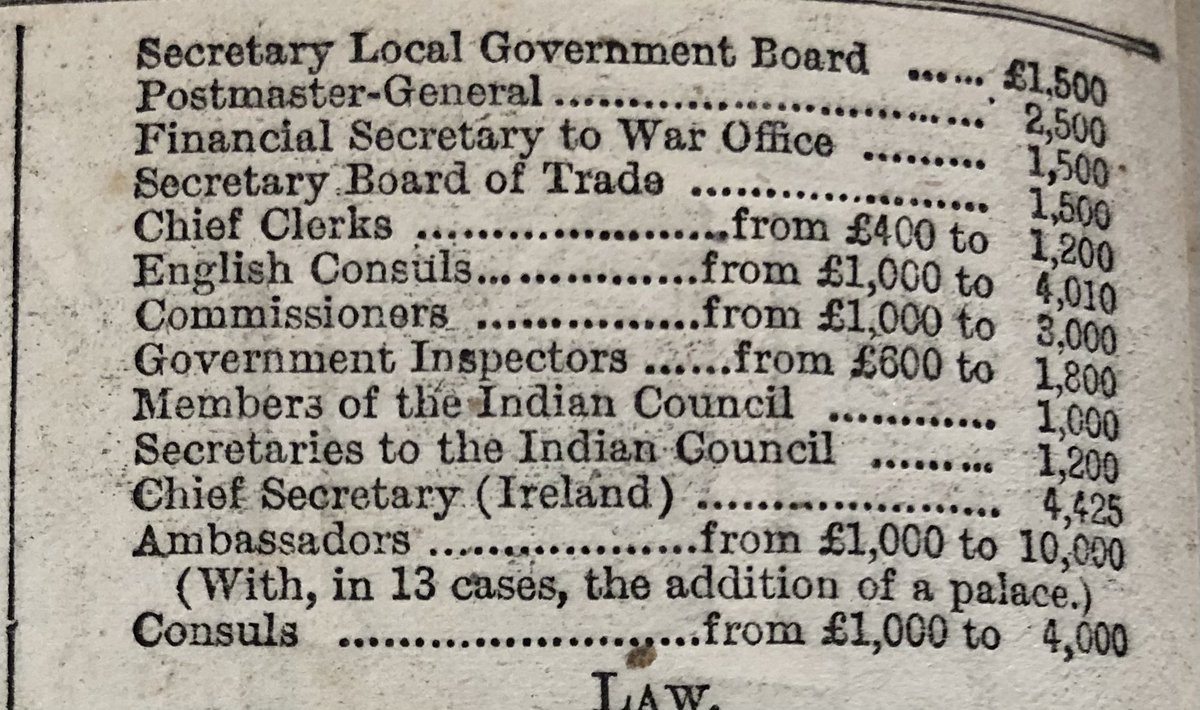Blimey, here’s a useful source for historians and novelists working on the Victorian era. Typical incomes for various professions, “from the Queen down to Her Majesty’s meanest subjects.”
— Tit-Bits, 20 Oct 1883.
— Tit-Bits, 20 Oct 1883.

Let’s take a closer look. Here’s the alleged annual income of several government officials in 1883. Interesting that the PM didn’t receive more than his cabinet members! 





It's hard to precisely compare the relative values of currencies over time, but it would appear that Boris Johnson's current salary of £155,000 is worth a *lot* less than Gladstone was earning in 1883.
(Not trying to drum up sympathy for Boris here)
(Not trying to drum up sympathy for Boris here)

The salaries of some middle and lower-middle-class professions in 1883. As we’ll see in a sec, some of them (like junior clerks) were earning less than skilled/experienced working class men. 

The earnings of working-class Victorians, expressed here as weekly wages, rather than an annual salary.
£1 = 20s (shillings).
1s = 12d (pence).
£100 a year = 38s 5d per week.


£1 = 20s (shillings).
1s = 12d (pence).
£100 a year = 38s 5d per week.



The annual income of domestic servants is particularly interesting, because it also captures some of the costs of running a middle/upper class household. Even the cheapest housemaid & cook would put a BIG dent in the finances of a someone earning under £100 a year. 

This helps to explain all the Victorian jokes about struggling, young clerks — characters with names like ‘Mr Quidaweek’ — who don’t have the cash to propose to a girl and set up a respectable middle-class household.
Ooops, nearly forgot the soldiers! Their earning are unhelpfully listed per day, though presumably (like domestic servants) also came with food and board? I don’t know much about 19thC army life, so please do correct me.
2s per day for a Sergeant = £36 10s per year.
2s per day for a Sergeant = £36 10s per year.

Tit-Bits doesn't provide any sources for this data, so use it with caution. However, (despite what their slightly frivolous name might imply) the magazine took great pride in being a source of accurate, well-researched facts. Think of them as something akin to QI.
I’ve checked the paper’s correspondence columns for the following month, and they don’t seem to have received (or at least printed) many corrections from readers. Here’s a snarky response to one letter on the subject! 

Some useful data for my fellow print historians scattered throughout:
Editors: £100-£1000
Reporters: £80-£500
Printers’ Readers: 40s-£6 (p/w)
Compositors: 28s-£4 (p/w)
Pressmen: 31s 6d (p/w)
Bookbinders: 20s-45s (p/w)
Lithographers: 30s (p/w)
Editors: £100-£1000
Reporters: £80-£500
Printers’ Readers: 40s-£6 (p/w)
Compositors: 28s-£4 (p/w)
Pressmen: 31s 6d (p/w)
Bookbinders: 20s-45s (p/w)
Lithographers: 30s (p/w)
As a few people have pointed out in replies, this section also reveals a substantial difference between industrial and agricultural workers, as well as the period’s gender pay gap.
As I understand it, agricultural labour was also seasonal. Not sure if/how that’s factored in here
As I understand it, agricultural labour was also seasonal. Not sure if/how that’s factored in here

• • •
Missing some Tweet in this thread? You can try to
force a refresh






















